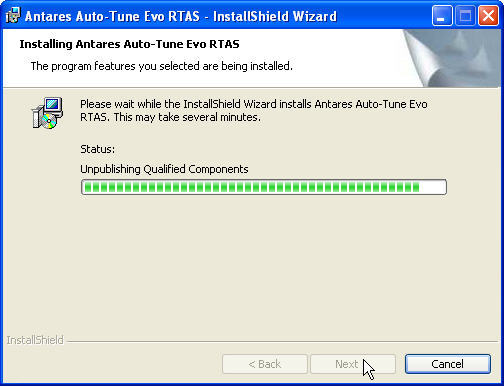

I saw this at the bottom of the screen in the task bar when Sonar was starting up. What was confusing to me at first was that even though Sonar was configured for 24/44.1, it would load the project and then switch to the correct bit depth and sampling rate. In my case, the project I was trying to load had been recorded at 24/48 but Sonar was configured for 24/44.1. The fix was to make sure that Sonar is completely configured for the bit depth and sampling rate of the project (which contains any instance of Auto-Tune) before you try to load that particular project. Yeah I probably didn't explain it very well. I'm really losing patience with this nonsense. Except this was a strange muffled version of the old problem. So I click on the X in the upper right corner and motorboating starts in. So I decided to just shut down Sonar and reopen it thinking I might have inadvertently done something wrong. So I pressed the space bar a few more times. I opened a project and once all the waveforms were done rendering, I pressed the space bar and nothing. But this was yet another unique version of it. I gotta make one other comment as long as I'm on a roll. This was not a problem in 8.01 or any previous version. I am gonna find it a little difficult to believe this bug (whatever it is they broke) only affects Antares Auto-Tune. I suggest you all check your plug-ins and make sure they all function properly. In V8.02 the graphical corrections are offset a step above the correct pitch. I can load a project with AT enabled on a track in V7 and it plays normally.

#ANTARES AUTOTUNE EVO TRIAL#
To wrap it up, users are advised to experiment with the functions of Auto-Tune Evo during the trial period and purchase a license if they are satisfied with its pitch correction capabilities.Gonna bump this one - I've done some further testing - the problem is not there in V7. The Options window brings extra settings that can be modified to change the buffer size, the total number of permitted undo actions, the bey bindings, and the window size. When using the interface buttons, one can create vibrato shape, adjust the amplitude and the formant amounts, along with the retune speed or the onset rate and variation. Users can select the one that best suits their necessities, to ensure all distortions are removed in a timely manner. In order to accommodate the needs of a wide range of users, this plugin supports multiple types of input types, such as soprano, alto/tenor, low male, instrument or bass inst.

In order to achieve this, it first detects the input's pitch, then finds the closest value from a previously user-defined scale (such as major, minor, chromatic, 26 historical and microtonal scales), depending on the effect they want to obtain.Īuto-Tune Evo also features a graphical mode that allows thorough and meticulous adjusting, as one can zoom in and out on the display window to get a better overview of the notes and pitch envelope they correct.

Once set up, it allows musicians to apply pitch correction onto their tracks and make sure the resulting sounds are smooth and clear.įurthermore, this plugin comes with an automatic mode that can be activated when one needs to correct live performances in real time. Since it is a VST plugin, it requires a compatible host before its functions can be accessed. Auto-Tune Evo VST is an audio plugin specifically created for this type of situations. Live performances are rarely as high-quality as the artists would like them to be, and when they want to distribute recordings of these events they occasionally resort to tweaking the sounds.


 0 kommentar(er)
0 kommentar(er)
